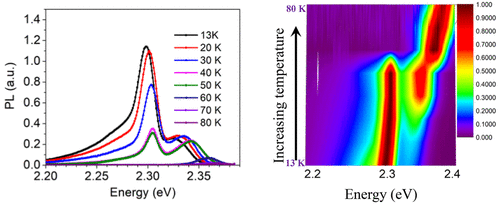当前位置:
X-MOL 学术
›
J. Phys. Chem. Lett.
›
论文详情
Our official English website, www.x-mol.net, welcomes your feedback! (Note: you will need to create a separate account there.)
Excitons in CsPbBr3 Halide Perovskite
The Journal of Physical Chemistry Letters ( IF 5.7 ) Pub Date : 2021-09-20 , DOI: 10.1021/acs.jpclett.1c02397 J A Peters 1, 2 , Z Liu 1 , O Bulgin 2 , Y He 3 , V V Klepov 3 , M C De Siena 3 , M G Kanatzidis 1, 3 , B W Wessels 1
The Journal of Physical Chemistry Letters ( IF 5.7 ) Pub Date : 2021-09-20 , DOI: 10.1021/acs.jpclett.1c02397 J A Peters 1, 2 , Z Liu 1 , O Bulgin 2 , Y He 3 , V V Klepov 3 , M C De Siena 3 , M G Kanatzidis 1, 3 , B W Wessels 1
Affiliation

|
Excitons in Bridgman grown halide perovskite CsPbBr3 single crystals were examined using photoluminescence (PL) spectroscopy to determine the nature of the electronic states. The photoluminescence intensity was strongly temperature-dependent and depended upon the specific exciton band. At low temperatures intrinsic disorder and its related shallow below bandgap tail states determine the emission properties. Photoluminescence at low temperature revealed the presence of several strong bands at the band edge that is attributed to free or trapped/bound excitons. This PL emission results from strong electron–phonon coupling with an average phonon energy Eph of 6.5 and 27.4 meV for the emissions, comparable to that observed in other perovskites. The Huang–Rhys parameter S was calculated to be 3.81 and 1.51, indicating strong electron–phonon coupling. The interactions between electrons and phonons produce small polarons that tend to bind charge carriers and result in trapped/bound excitons. The transient photoluminescence response of each specific band was studied, and the results indicated a multiphonon recombination process. Average PL lifetimes of ∼17 ns for free excitons and ∼38 ns for trapped/bound excitons were determined. The observed edge states could be associated with native defects such as vacancies and interstitials, as well as twinning due to the cubic-to-tetragonal phase transition in CsPbBr3. Elimination of the trapping sites for binding excitons could lead to improved charge transport mobilities, carrier lifetimes, and detector properties in this system.
中文翻译:

CsPbBr3 卤化物钙钛矿中的激子
使用光致发光 (PL) 光谱检查布里奇曼生长的卤化物钙钛矿 CsPbBr 3单晶中的激子以确定电子态的性质。光致发光强度强烈依赖于温度并取决于特定的激子带。在低温下,内在无序及其相关的浅带隙尾态决定了发射特性。低温下的光致发光揭示了在带边缘存在几个强带,这归因于自由或俘获/束缚激子。这种 PL 发射来自强电子 - 声子耦合,发射的平均声子能量E ph为 6.5 和 27.4 meV,与在其他钙钛矿中观察到的相当。Huang–Rhys 参数S计算为 3.81 和 1.51,表明强电子 - 声子耦合。电子和声子之间的相互作用会产生小的极化子,这些极化子往往会结合电荷载流子并导致被困/结合的激子。研究了每个特定波段的瞬态光致发光响应,结果表明存在多声子复合过程。确定了自由激子的平均 PL 寿命约为 17 ns,捕获/束缚激子的平均 PL 寿命约为 38 ns。观察到的边缘状态可能与天然缺陷有关,例如空位和间隙,以及由于 CsPbBr 3 中立方到四方相变导致的孪晶. 消除结合激子的俘获位点可以改善该系统中的电荷传输迁移率、载流子寿命和检测器特性。
更新日期:2021-09-30
中文翻译:

CsPbBr3 卤化物钙钛矿中的激子
使用光致发光 (PL) 光谱检查布里奇曼生长的卤化物钙钛矿 CsPbBr 3单晶中的激子以确定电子态的性质。光致发光强度强烈依赖于温度并取决于特定的激子带。在低温下,内在无序及其相关的浅带隙尾态决定了发射特性。低温下的光致发光揭示了在带边缘存在几个强带,这归因于自由或俘获/束缚激子。这种 PL 发射来自强电子 - 声子耦合,发射的平均声子能量E ph为 6.5 和 27.4 meV,与在其他钙钛矿中观察到的相当。Huang–Rhys 参数S计算为 3.81 和 1.51,表明强电子 - 声子耦合。电子和声子之间的相互作用会产生小的极化子,这些极化子往往会结合电荷载流子并导致被困/结合的激子。研究了每个特定波段的瞬态光致发光响应,结果表明存在多声子复合过程。确定了自由激子的平均 PL 寿命约为 17 ns,捕获/束缚激子的平均 PL 寿命约为 38 ns。观察到的边缘状态可能与天然缺陷有关,例如空位和间隙,以及由于 CsPbBr 3 中立方到四方相变导致的孪晶. 消除结合激子的俘获位点可以改善该系统中的电荷传输迁移率、载流子寿命和检测器特性。


























 京公网安备 11010802027423号
京公网安备 11010802027423号